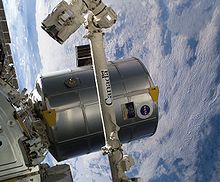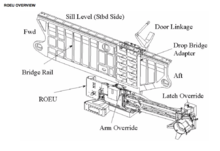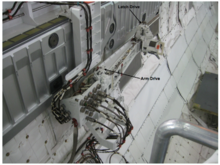- Multi-Purpose Logistics Module
-
A Multi-Purpose Logistics Module (MPLM) is a large pressurized container used on Space Shuttle missions to transfer cargo to and from the International Space Station (ISS). An MPLM was carried in the cargo bay of a Shuttle and berthed to the Unity or Harmony modules on the ISS. From there, supplies were offloaded, and finished experiments and waste were reloaded. The MPLM was then reberthed in the Shuttle for return to Earth. Three modules were built by the Italian Space Agency (ASI), Leonardo, Raffaello and Donatello.[1]
The Leonardo module was modified in 2010 to turn it into the Permanent Multipurpose Module (PMM) and was permanently attached to the ISS during the STS-133 mission in March 2011.
There were 34 Space Shuttle missions to the ISS. MPLMs were flown twelve times, with SPACEHAB modules flown nine times to ISS, and 25 Shuttle missions delivering construction elements, in various combinations.
Note to support certain stowed equipment and experiments inside the MPLM they were electrically connected to the Shuttles power supply by means of the Remotely Operated Electrical Umbilical (ROEU). The ROEU was mounted on the starboard side payload bay sidewall longeron, and was a folding arm umbilical that was connected to the MPLM while it was in the payload bay. The arm was disconnected and retracted prior to the MPLM being removed for placement on the ISS and then reconnected once the MPLM was placed back inside the payload bay.
Contents
History
The modules were provided to NASA under contract by the Italian Space Agency (ASI). Three MPLMs were built and delivered to NASA and have names chosen by the ASI to denote some of the great talents in Italian history: Leonardo da Vinci, Raffaello and Donatello. Although built by ASI, the modules are owned by NASA. In exchange for building the MPLMs, ASI receives access to U.S. research time on the ISS.[1]
The MPLMs have a heritage that goes back to Spacelab.[2] In addition, ESA's Columbus module, the Harmony and Tranquility ISS modules and the ATV and Cygnus resupply craft all trace their origins to the MPLMs.[2] The MPLM concept was originally created for Space Station Freedom. Initially, they were to be built by Boeing, but in 1992, the Italians announced that they would build a "Mini-Pressurized Logistics Module", able to carry 4,500 kilograms (4.5 t) of cargo. After the 1993 redesign of Freedom, the length was doubled and it was renamed the "Multi-Purpose Logistics Module". Each empty MPLM is approximately 21 feet (6.4 m) long, 15 feet (4.6 m) in diameter, weighs 4,400 kilograms (9,700 lb), and can deliver up to nine metric tonnes of cargo to the ISS.[1]
Donatello was a more capable module than its two siblings, as it was designed to carry payloads that required continuous power from construction through to installation on the ISS. However, Donatello was never used and some of its parts were cannibalized to convert Leonardo into the PMM.[3]
With the end of the Space Shuttle program in 2011, the Raffaello and Leonardo modules were flown a combined total of 12 times.
Program logo
Since the module names are also the names of three of the four Teenage Mutant Ninja Turtles, the NASA MPLM Group designed a logo with a ninja turtle in an astronaut flight suit.[4] Because the Ninja Turtles are copyrighted by Mirage Studios, NASA gave Mirage the copyright to the logo in exchange for the use of the studio's character on it.[4]
Missions
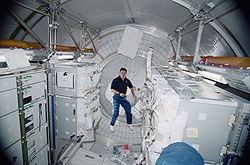 21 March 2001 – Cosmonaut Yuri P. Gidzenko is dwarfed by transient hardware aboard Leonardo.
21 March 2001 – Cosmonaut Yuri P. Gidzenko is dwarfed by transient hardware aboard Leonardo.
Flight Launch Date Mission Shuttle MPLM Mass Up
(kg)Mass Down
(kg)1 8 March 2001 STS-102 ISS 5A.1 Discovery Leonardo 10,213 6,540 2 19 April 2001 STS-100 ISS 6A Endeavour Raffaello 8,811 6,763 3 10 August 2001 STS-105 ISS 7A.1 Discovery Leonardo 9,467 7,799 4 5 December 2001 STS-108 ISS UF-1 Endeavour Raffaello 9,228 8,693 5 5 June 2002 STS-111 ISS UF-2 Endeavour Leonardo 10,753 9,140 6 26 July 2005 STS-114 ISS LF 1 Discovery Raffaello 8,301 9,110 7 4 July 2006 STS-121 ISS ULF 1.1 Discovery Leonardo 9,588 8,124 8 14 November 2008 STS-126 ISS ULF 2 Endeavour Leonardo 12,748 6,966 9 28 August 2009 STS-128 ISS 17A Discovery Leonardo[5] 12,601 8,927 10 5 April 2010 STS-131 ISS 19A Discovery Leonardo 12,371 9,242 11 24 February 2011 STS-133 ISS ULF5 Discovery Leonardo PMM N/A - part of ISS 12 8 July 2011 STS-135 ISS ULF7[4] Atlantis Rafaello 9,500 5,660 Specifications
The following are the specifications of the MPLM[6] :
- Length – 6.6 m (cylindrical part 4.8 m)
- Width – 4.57 m
- Mass – 4,082 kg empty; 13,154 kg fully loaded
- Habitable volume – 31 m3
References
- ^ a b c "Multi-Purpose Logistics Modules". NASA. 2007. http://www.nasa.gov/mission_pages/station/structure/elements/mplm.html.
- ^ a b "A new European science laboratory in Earth orbit". http://esamultimedia.esa.int/docs/columbus/newspaper/ESA_ColumbusLab_newspaper_ENG.pdf.
- ^ http://www.spaceflightnow.com/shuttle/sts133/101007payloads/
- ^ a b c "Multi-Purpose Logistics Module Office". NASA MSFC. http://mplm.msfc.nasa.gov/. Retrieved February 22, 2009.
- ^ Chris Gebhardt (2008). "STS-128 – Atlantis' 2009 mission baselined by PRCB". NASAspaceflight.com. http://www.nasaspaceflight.com/2008/08/sts-128-atlantis-2009-mission-baselined-by-prcb/.
- ^ NASA. "What is MPLM?". http://mplm.msfc.nasa.gov/mission.html. Retrieved 11 June 2011.
External links
NASA Space Shuttle (STS) Core topics 


Components Orbiters Add-ons Sites Operations Missions (cancelled) · Crews · Mission timeline · rollbacks · Abort modes · Rendezvous pitch maneuverTesting Disasters Support Special Derivatives Related Space Shuttle design process · Inertial Upper Stage · Payload Assist Module · ISS · Space Shuttle retirement · Explorer (shuttle replica)Components of the International Space Station Overview Assembly · US Orbital Segment · Russian Orbital Segment · Expeditions · Spacewalks · ISS Program · Scientific Research · Major Incidents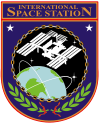
Major components
in orbitZarya (Functional Cargo Block) · Zvezda (Service Module) · Unity (Node 1) · Harmony (Node 2) · Tranquility (Node 3) · Destiny (Laboratory) · Columbus (Laboratory) · Kibō (PM, ELM-PS, EF) · Quest (Airlock) · Pirs (Airlock / Docking Module) · Rassvet (MRM 1) · Poisk (MRM 2) · Leonardo (PMM) · Cupola · Integrated Truss Structure (ITS)Subsystems
in orbitFlight-ready hardware
with no launch planMulti-Purpose Logistics Modules (MPLMs) · Kibō (ELM-ES) · ExPRESS Logistics Carrier (ELC) 5 · Interim Control Module (ICM)Scheduled for launch
by ProtonProposed module Cancelled Support vehicles Current: Soyuz · Progress · Automated Transfer Vehicle (ATV) · H-II Transfer Vehicle (HTV)
Future: Dragon · Cygnus · Orion · Rus · CST-100
Former: Space ShuttleMission control centers Categories:- Supply vehicles for the International Space Station
Wikimedia Foundation. 2010.


